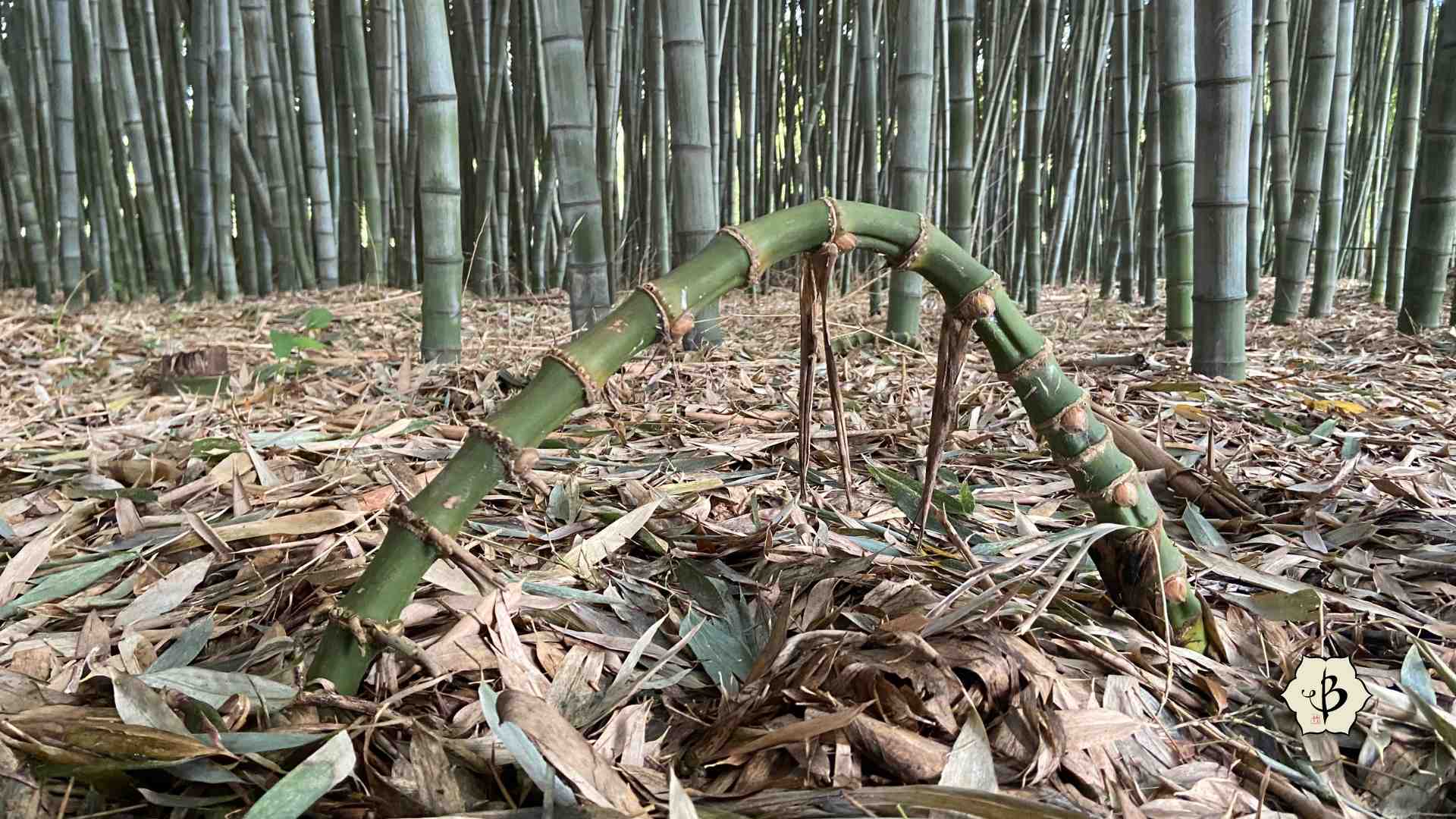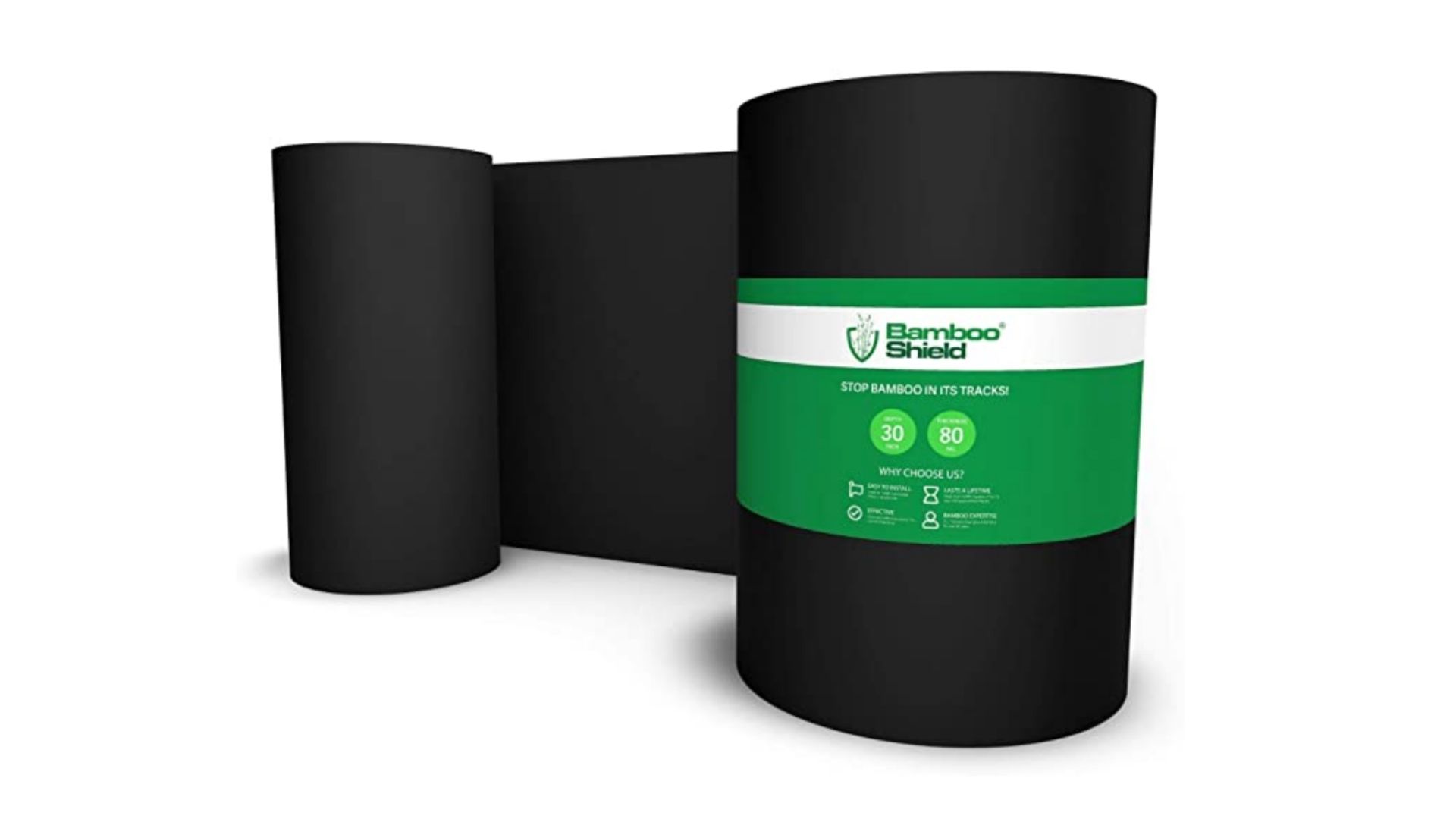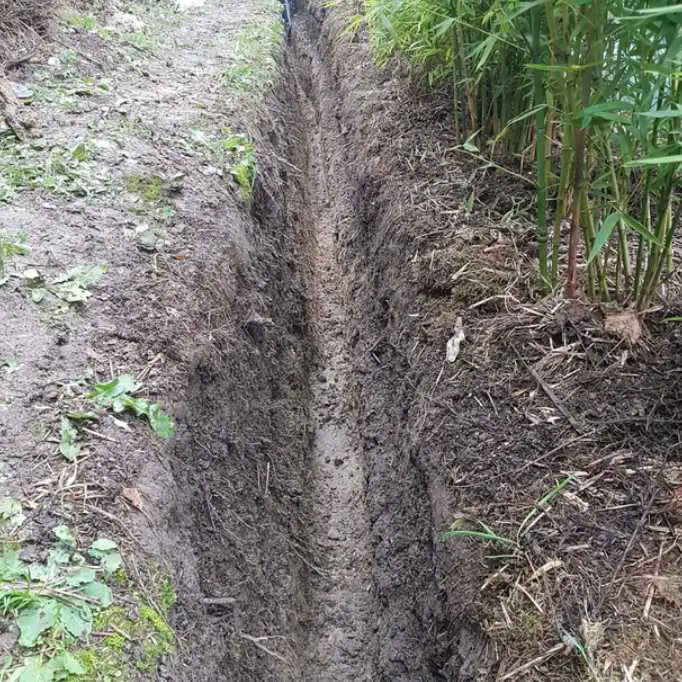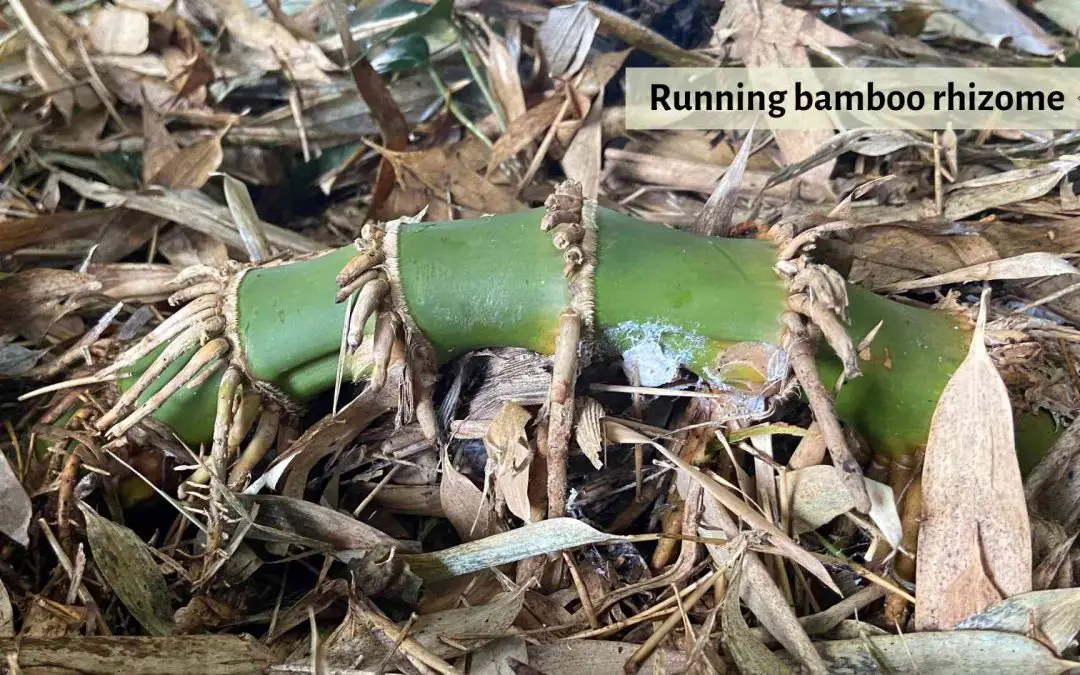There’s an old saying among seasoned bamboo growers. “The first year it sleeps, the second year it creeps, and the third year it leaps.” Those wanting a quick spreading hedge or grove in their backyard might be disappointed with their new stand of bamboo after the first 6 or 12 months. But it won’t be long before they’re running for their chainsaws and pick axes, desperate to curtail an out-of-control root system.
Without an effective containment strategy, some types of bamboo can get out of control. But managing and enclosing a healthy bamboo grove is easier than many people believe. One of the best methods is to plant a clumping bamboo species which won’t spread out. Otherwise, we recommend using a root and rhizome barrier or digging a containment trench, as we explain below.
NOTE: This article first appeared in December 2018, most recently updated in July 2024.
The importance of bamboo containment
Before you plant that super sustainable and renewable bamboo specimen in your garden, you’ll need to have a clear strategy for containment. Without proper preparation and foresight, a vigorous bamboo plant can easily grow into an invasive menace. To prevent this sort of mishap, you will need to dig a trench or install some kind of impenetrable barrier.
If it’s already too late for prevention, and the bamboo start you planted just two or three years ago is already running amok, then you’ll want to consider some methods of bamboo abatement and eradication. Removing bamboo is not an easy process, especially if it’s a well-established specimen of the running variety. But there are a couple techniques that have proven effective.
Worse yet, maybe your neighbor went gung-ho a few years back after an inspiring trip to the home and garden show (or a quick glance at this rousing article on the best bamboo varieties). And now his short-sighted dream of a Japanese garden is turning into a nightmare of bamboo rhizomes wreaking havoc on your fence line, your flower beds, your veggie patch and your sprinkler system. In this case, you’ll want to study up on both topics mentioned above, in addition to possibly signing up for a course on non-violent communication.
When it comes to time make peace with your neighbor, you’re on your own. But this article will help you with the first two issues, bamboo containment and bamboo removal. In the end, this can prevent you from becoming the kind of gardener whose neighbors want to come after them with a bulldozer in the night.
You can also check out our list of recommended bamboo gardening supplies, including a number of bamboo containment tools.
Understanding bamboo behavior
If you’re planting a fast-growing (read: aggressively spreading) bamboo privacy hedge, or one of the popular and massive timber bamboos, and you live in a neighborhood (as opposed to rural farmland), then a good rhizome barrier is absolutely essential.
Here are a couple things you will need to keep in mind. First of all, never underestimate the tenacity of a healthy bamboo plant. Bamboo is a force of nature unlike any other. People like to talk about runners vs. clumpers, and it’s it’s an important distinction to be aware of.
But as they mature, all bamboos display the undeniable will to spread out. You can put bamboo into a pot or a barrel, but don’t kid yourself. If there’s a crack in the barrel or a hole in the pot — and surely there is — the bamboo roots will eventually find their way out. And if there’s soil below, the roots will take hold faster than you can say Phyllostachys!
Take a look at this article on choosing the Best Varieties of Clumping Bamboo.
Bamboo super spreaders
Also know that those little rhizomes have an amazing ability to sniff out a good water supply, especially in a dry climate like California. That means, if you have some bamboo in the ground, and one of your neighbors has a drip irrigation in their herb garden, or they regularly run their sprinkles to keep the lawn green, it’s very likely that your bamboo will send out runners headed straight for that water source.
It’s like the bamboo has a kind of plant ESP. But just wait till those well-watered roots start sprouting up new shoots in the neighbor’s perfect lawn like UFOs (Underground F#@&ing Objects). Don’t expect them to be welcomed with open arms.
And don’t think you can just yank those unwanted sprouts from the soil like a handful of pesky dandelions. It’s not unheard of for people to rent a backhoe or a bulldozer to really clear out an established stand of bamboo. Otherwise, count on spending a few hours with a spade, maybe a pick ax, maybe even a Sawzall (reciprocating saw), to keep those running rhizomes at bay. And you’ll need to do that sort of maintenance at least once or twice a year if you really want to keep your bamboo from getting the upper hand.

Root barriers to contain your bamboo
After many centuries of man and bamboo butting heads, and bamboo almost always coming out the winner, some brilliant gardener(s) finally devised a virtually impenetrable system of bamboo containment to help keep your grass where it belongs.
These days you can (and should) buy sheets of extremely durable black polyethylene, about 1.5-2 mm in thickness, and usually 24″ to 30″ in width. Bamboo barriers normally come on a roll, anywhere from 25 to 100 feet in length. You might think 24″ is plenty. After all, who wants dig a 3 foot trench all the way around their hedge? But trust me, use at least 30″, you’ll be better off in the long run. Like I said before, never underestimate the perseverance of a bamboo.

Bamboo Shield makes an excellent root barrier product. The barrier, available from Amazon, comes in a variety of sizes, for different climates and soil types. The warmer the climate, the thicker the barrier. The experts recommend 30″ deep barriers, unless you have sandy soil, in which case 36″ is better. For best results use 80 mil. (It’s confusing, but a “mil” is a thousandth of an inch, so 80 mil equals 2 mm.)
It’s probably the most effective way to keep your bamboo hedge in a well-defined area. Consider it a hundred bucks or so well spent on your peace of mind and good neighbor relations.
Creating an obstacle against expansion, the root barrier might cause the roots to run a little deeper than they normally would. So always get a deeper root barrier if you’re not sure which size to use. And keep an eye on the top of the barrier as well, because bamboo roots are perfectly capable of hopping over a low barrier, especially if they’re lying under a layer of leaf mulch.
Check out our detailed article on Bamboo Root Barriers to learn more.
Alternative containment strategies
As an alternative to burying a robust rhizome barrier, some gardeners prefer to dig a trench or moat around their bamboo groove. This allows you to keep a closer eye in the root activity, so you can simply prune them back with some heavy clippers when you see the rhizomes preparing to breech.
For best result, the trench should be about 1 foot deep and 1 foot wide. If you have aggressive running bamboo, like a Phyllostachys variety, for example, you’ll want to inspect the trench a couple times a year. The trench makes it easy to spot the running rhizomes and nip them in the bud.
Some people leave their trench open, while others fill it with something that’s easy remove. Straw or dry leaves look good, and it’s easy to sift through and examine the rhizome activity on a regular basis. Others prefer to fill the trench with concrete and just be done with it.

Another strategy is to keep your bamboo plants in pots. Potted bamboo has certain advantages, but you’ll need to transplant these specimens on a pretty regular basis to prevent them from getting root bound. Also be careful that the roots don’t pass through the drain hole in the bottom of the pot and establish themselves in the ground.
How to remove bamboo
OK, so it’s already too late. You or your neighbor let some bamboo run free, and now it’s just out of control. Is there an easy way to get rid of it? Well yes, there are ways to get rid of it. But none of them are very easy.
First you’ll need to cut it down to the ground, as low as possible. And then start digging. Pull out roots and rhizomes as you go. And keep on digging. If it’s a particularly tenacious variety you may want to reach for a pick ax or a hand saw. If nothing else works, or your back just isn’t up for this type of labor, your best best will be the Sawzall. As the name suggests, these things saw through anything.
The top of the line piece is Makita’s Cordless Recipro Saw Kit, sold complete with saw blades and an extra battery.

Or you could save a few bucks with a similar Dewalt 12 Amp Corded Reciprocating Saw.
Extreme bamboo removal measures
In some cases, a neglected stand of bamboo may spread for years and form an indestructible network of rhizomes. Such a thriving bamboo grove will create something like an ecosystem of its own, attracting a variety of birds and wildlife. But when it comes time to remove this bamboo, it may require nothing less than a bulldozer to do the job.
Some gardeners like to get creative when eradicating bamboo. I’ve heard of people using everything from Roundup to gasoline to do away with an unwelcome plant. Please note that these are not techniques that we recommend. But since it’s a common question, we do have more advice on how to get rid of bamboo elsewhere on our website.
In any case, don’t let these tools and cautionary tales frighten you out of planting an amazing grove of bamboo. With proper preparation, these incredible products make it possible for even the suburban gardener to plant an astonishing stand that the whole neighborhood can enjoy!
Further reading
To learn more about expert bamboo gardening, check out some of our other popular articles.
- How to Grow Bamboo: The Ultimate Guide
- How to choose the best bamboo
- Genus Fargesia: Clumping bamboo for cold climates
- How to get rid of bamboo: Remove the menace
- Running Bamboo: Why would you plant it?
- Pros and Cons of potted bamboo
FEATURE IMAGE: Running bamboo (Phyllostachys) rhizomes can travel far and wide if not managed properly. Photo by Fred Hornaday.


























Great resource Fred. Thanks. I live in San Diego (coastal) and am thinking of adding some bamboo along a property line in 6’-8’ sections. My lot is 3’ lower than neighbor and the property line has a 3’ cinderblock retaining wall sitting on a foot or so of foundation cement. Will bamboo roots go under than wall and push up through 3’ of soil to surface on the other side? It will also be surrounded by 3’ wide cement walkway.
Thanks, David. A 3-foot deep cinder block should be pretty effective. In San Diego, you will have no problem with clumping bamboo. I’d suggest some ornamental variety of Bambusa, such as textilis or multiplex or sea breeze.